Showing 10–18 of 1093 resultsSorted by latest
-
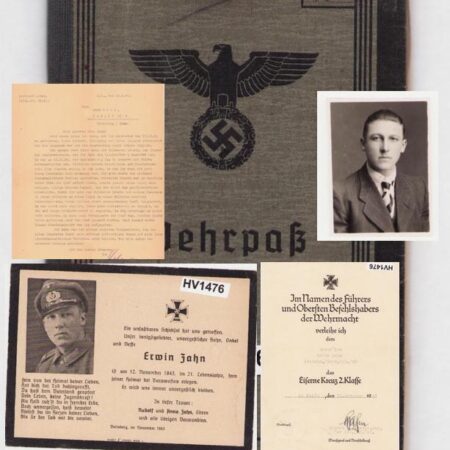
Original WWII German Wehrpass Grouping – Gefreiter Erwin Zahn – Grenadier Regiment 348 – 216 Infanterie Division – Iron Cross – Letters Fully Translated – Isle of Man Link! Rare
Sad grouping to Family Zahn. Wehrpass – Issued to Erwin Zahn – Born 1924 – Holder of HJ Sport Badge – did his RAD service in Graz – called up in December 1942 – joined his frontline unit in September 1943. Grenadier Regiment 348 – 216 Infanterie Division In July 1943, the 216th Infantry Division participated in the Battle of Kursk, where it sustained heavy casualties while fighting on the northern shoulder of the Kursk salient as part of Generalfeldmarschall Model’s Ninth Army. The division was disbanded on 17 November 1943 after suffering heavy casualties during the retreat to the Dnieper River Defensive Line. Zahns death card and Iron Cross Second Class Certificate, one spare photo in the back pouch as well as his death certificate. He will killed on the 12.11.1943 – the letter to his mother Anna reads: Lieutenant Leber,Field Post No. 21360 O.U., 14 April 1944 Mrs. Anna Zahn,Kowald No. 4,Voitsberg / Stmk. Dear Mrs. Zahn, Only today am I able to reply to your letter of 17.12.43. Due to operations, relocations, and my longer absence from the company, it was not possible for me to respond earlier. I spoke about your son with Sergeant Droste, the leader of the bicycle platoon to which your son belonged as a light machine gunner. On 12.11.43, the bicycle platoon was in reserve and carrying out entrenching work. Suddenly, enemy artillery fire began. A shell struck the pit in which your son and another comrade were working. Your son was fatally struck by multiple shell fragments. Sergeant Droste was in the immediate vicinity and ran to him at once, but he could provide no further help. A few hours later, after the enemy artillery fire subsided, your son was buried with Sergeant Droste and his comrades in a field grave on a hill in a small woodland west of Borschtschownka, a heavily destroyed small village. It was not possible to move your son further in order to bury him in a “heroes’ cemetery,” as the combat situation no longer allowed it. Since there was also no camera available, unfortunately no photographs of the grave could be taken. Soon after, this section of the front was abandoned. Your son was very popular with his immediate superiors and with all his comrades for his open, sincere nature and his always comradely conduct. It is with heavy hearts that we had to part from him! With best regards,Your [signature: Leber] The letter from the Doctor dated in 1945 relates to Annas Brother who was also Killed in Action. Dr. Bantz, Staff Doctor Deputy Chief Doctor Field Post Number: 36 77 0 O.U., 29 January 1945 Dear Mrs. Zahn, It is my sad duty to inform you that your dear brother, Oberjäger Peter Zeltmeister, died on 28.1.1945 after being admitted to our field hospital. Your brother had sustained a severe head wound with brain involvement. Death occurred during transport to the hospital. For more detailed information, I would kindly ask you to contact the last field unit of your brother. Please accept my sincere condolences on this grievous loss. Your dear brother made the ultimate sacrifice for the Fatherland and homeland in heavy fighting. His comrades will remember him as a good soldier, and I ask you also to preserve a worthy memory of him. The deceased will be laid to rest on 30.1.1945, in a dignified ceremony, alongside his comrades in a single grave at the soldiers’ cemetery in Csatkornya (Hungary). All personal belongings found with the deceased will be forwarded to you. Heil Hitler! Yours, [signature] Dr. Bantz Staff Doctor and Deputy Chief Doctor Interestingly two POW Letters are included and are from Annas Sister Hedwig, who for some reason was in an all female POW on the Isle of Man – the only such camp for females in WWII! Port Erin Women’s Detention Camp was a World War II internment camp on the Isle of Man at Port Erin. It was Europe’s only all-female internment camp. Notable internees included Dora Diamant, the lover of Franz Kafka in the last year of his life, and Fay Taylour, champion motorcycle, speedway and racing car driver. See more on the camp here: https://www.bbc.com/news/world-europe-isle-of-man-32810383 Translations: 26.4.1943 My dear sister Anna, Many thanks for your letter of 28.1.43, which unfortunately arrived so late that I could not reply sooner. Dear Anna, I believe this heavy burden is even harder for you and your family than it already is. Instead of resigning yourself to the inevitable and trying to make the best of it, you lament and cry and thereby suffer much more. But apparently that is the way of millions of mothers. They have to bear much heavier sorrows. But Anna, I am sorry, yet I do not blame you. On the one hand, you have a cheerful spirit that often helps you to bear much adversity. For you and others like you, only sorrow and pain come again and again. But you, with heart and soul, must stand by the Fatherland in this difficult time, whether or not you believe in it. Believe me, Anna, I have seen much among friends, and it is only about one Fatherland — one Germany — defending our cause. If sacrifices are demanded, then one day everything will be good again. With love for Hilda, my Fatherland. Your sister, H Another Letter translated: “AVEN HOLME.” G.H. Post Erin I.O.M. 26.4.1943 My dear sister Anna, Many thanks for your letter of 28.1.43, which unfortunately arrived so late. Dear Anna, I believe you and your loved ones are making life even harder for yourselves than it already is. Instead of accepting the inevitable and trying to make the best of it, you lament and weep, and in doing so you suffer much more. Yet it seems that this is the way of millions of mothers, who must bear even heavier sorrows. Anna, I am sorry, but I do not reproach you. On the one hand, you always keep a cheerful…
-
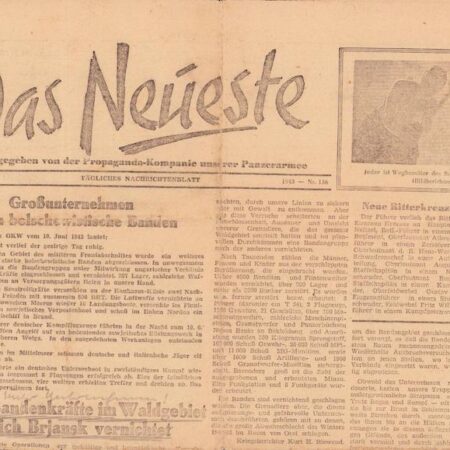
Original WWII German Propaganda Newspaper – “Das Neueste” – Panzerarmee – Anti-Partisian Operations – Rare
Issued by the propaganda company of a German Panzer Army front-line propaganda material. Date: Friday, 11 June 1943. Issue No. 135. Main headline: Großunternehmen gegen bolschewistische Banden (Major operation against Bolshevik bands). This refers to German anti-partisan campaigns in occupied Eastern territories. Other headlines: Starke Bandenkräfte im Waldgebiet südlich Pinsk vernichtet (Strong bandit forces in the forest area south of Pinsk destroyed). Highlighting supposed German successes against Soviet partisans, aiming to keep morale up at the front. There is also a blurry photo print of soldiers (caption: “Jeder ist Wächter der Front” – Everyone is a guardian of the front). Continuation of reports about anti-partisan operations. Sections on: “Schlagkräftige Züge” (Effective platoons) – praising German units’ efficiency. “Vom Feind” (From the enemy) – reports on Allied and Soviet movements, presented in a way to minimize German losses and emphasize enemy suffering. “Einzelschicksal – von den Hornen” (Individual fate – from the Horns) – a kind of war story highlighting the courage of German soldiers. Includes names of war correspondents (e.g., Heinz Brandt, Hans Zickel).
-
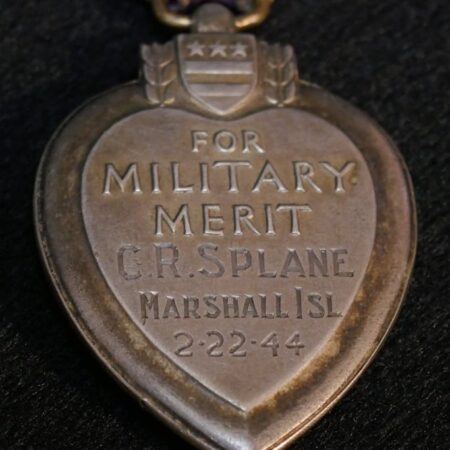
Original WWII Purple Heart – Pfc C R Splane – USMCR – Battle of Enewetak Atoll – Wounded in Action
Here we have a nice Purple Heart with what seems to be a private engraving. After researching it, it would seem he was wounded in the Battle of Enewetak Atoll. Charles R Splane from Nevada Member of the 22nd Marine Regiment. Marshall Islands: Battle of Eniwetok (22nd Marines: Navy Unit Commendation, February 17 to 22, 1944) On February 18, 1944, the 22nd Marines under the command of Colonel John T. Walker, participated in the Battle of Eniwetok, in the northwest area of the Marshall Islands, capturing the islands of Engebi in 6 hours, Eniwetok Atoll on February 21 with the 1st and 3rd Battalions of the 106th Infantry Regiment of the 27th Infantry Division, and Parry on February 22. The 22nd Marine proceeded to take Kwajalein and Roi-Namur from March 7 to April 5. This was the first Marine Corps unit to formally employ fire team tactics in combat. On April 6, the Marine regiment was sent to Guadalcanal for rest, replacements, and further training. I found more information here: https://genealogytrails.com/nev/state/ww2navyhonor.html https://en.wikipedia.org/wiki/22nd_Marine_Regiment https://www.history.navy.mil/content/history/museums/nmusn/explore/photography/wwii/wwii-pacific/gilbert-marshall-islands-campaign/invasion-marshall-islands.html
-
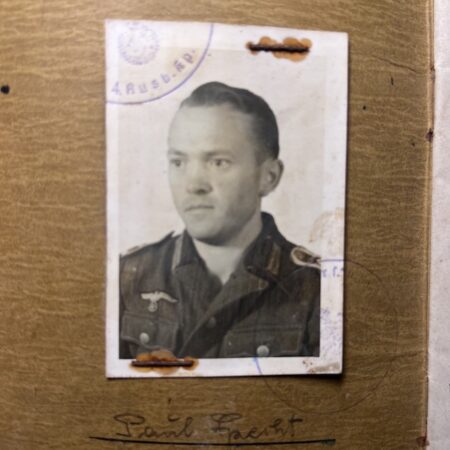
Original WWII German Soldbuch – Feldwebel Paul Specht – Panzer Grenadier Regiment 26 – 24 Panzer Division – Heiligenbeil 1945 – Rare
Soldbuch to Feldwebel Paul Specht It seems his Soldbuch was issued as a replacement with: Panzer Ersatz und Ausbildungs Abteilung 10 in September of 1944. Specht spent time in Litzmanstadt (Lodz) in 1944, with: Panzer Grenadier Ersatz Batl 413, and it seems they went into action there January 1945 and were almost wiped out. https://www.lexikon-der-wehrmacht.de/Gliederungen/InfErsBat/InfErsBat413-R.htm Specht was finally mobilised and sent via Marschbataillon Pz.Tr./307 to the 24. Panzer-Division, (Strength 300 Mann 4.1.1945 Wehrkreis X) Specht was assigned to his frontline unit of the 24 Pz Div – Panzer Grenadier Regiment 26 – 1 Schwadron Commanded by: Major Höhne (RK,DKIG) Killed in Action – February 19th, 1945 (Zinten, Heiligenbeil/Eastprussia, Germany) His Profile: https://www.tracesofwar.com/persons/6832/H%C3%B6hne-Georg.htm The division was then transported by rail, leaving behind its heavy weapons and armored vehicles, to Marienburg/Elbing (East Prussia). In the Elbing area, it was provisionally re-equipped with weapons and vehicles. The division was then deployed for defense and counterattacks in Southeast Prussia. From February 21 to March 27, 1945, defensive fighting followed in Ermland and the division withdrew to the bridgehead near Heiligenbeil. At the end of March 1945, the division was transported across the Baltic Sea to the Vistula Spit near Pillau. In mid-April, the remnants of the division (approximately 4,000 to 5,000 soldiers) were evacuated to Schleswig-Holstein, where it surrendered. Interesting Equipment: Peaked Visor Cap, Camo Kit Medals/Awards: Shooting Lanyard, 1st Class – 22.7.1941, Sports Badge in Bronze – 31.7.1941, War Merit Cross with Swords 20.4.1943. Fate: I have checked online resources and was not able to find what happened to Specht, although it could be that he made it back to Germany and surrendered, although there is no POW markings on the Soldbuch, a mystery that may later be solved…
-
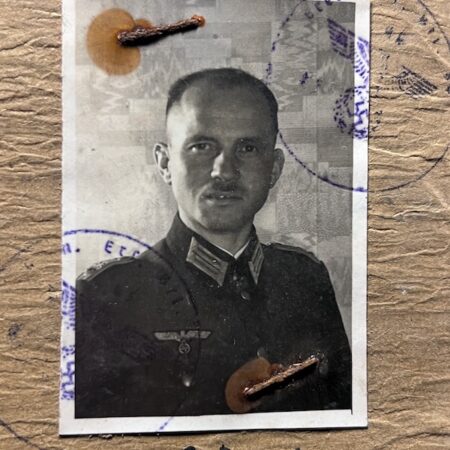
Original WWII German Soldbuch – Oberleutnant Ringel – Italy Milan 1943 – Grenadier Regiment 216 – 102 Inf Div – Iron Cross First Class – Escaped Pillau 1945 – POW Western Front! – Rare
Soldbuch issued in 1941 to Stone Mason Master from the area of Braunau (CZ), Arno Ringel. Frontline Units: Landesschützen Batl 554 The Landesschützen Battalion IV/VIII was established during mobilization on August 26, 1939, in Görlitz, in Wehrkreis VIII. The battalion was formed from the Infantry Replacement Battalion 406. The battalion was apparently deployed to Reichenbach during the winter of 1939/40. On April 1, 1940, the battalion was renamed Landesschützen Battalion 554. The battalion was subordinated to Division z.b.V. 408. From there, the battalion was deployed to the Commander of the VIII Prisoners of War. Feldkommandantur 1013 Field Command 1013 was established on August 22, 1943, in Military District VIII. Subsequently, the staff was subordinate to the General Staff of the 14th Army and then to the Plenipotentiary General of Italy and was located in Milan. Regiments Gruppe 348 – (102 Infanterie Division) Wounded in May 1944 – Bullet wound!! Interestingly the unit is mentioned here: https://www.lexikon-der-wehrmacht.de/Gliederungen/Divisionsgruppe/DivGruppe216.htm Field Post Numbers: The units (Staff, Regimental Groups, and 14th Company) were all registered in the field post overview as parts of Divisional Group 216 from January 10, 1944. The 13th Company followed on March 22, 1944. The 13th and 14th Companies were then assigned to Regimental Group 348 from May 22, 1944. The regimental groups and the staff were renamed parts of Grenadier Regiment 216 between November 23 and 29, 1944. Grenadier Regiment 216 ( 216 Infanterie Division) – Seems this was his last unit. From August onward, the division continued its retreat across the Lessna, the Bug, and the Narew Rivers to the East Prussian defensive position until January 1945. At the end of 1944, Division Group 216 was renamed Grenadier Regiment 216. After the costly battle for East Prussia, the remnants of the division withdrew via Sensburg and Heilsberg to the Königsberg area. The division was finally smashed in the Rosenberg-Balga-Heiligenbeil pocket. Remnants managed to escape across the Frisches Haff to Pillau. These remnants continued fighting in Western Pomerania as Division Group 102, surrendering to the Americans at Trave on May 5, 1945. Awards: War Merit Cross with Swords, Second Class, Jan, 1944, April 1944 – Iron Cross Second Class and Wounds Badge in Black, February 1945 – Iron Cross First Class – 102 Infanterie Division. He seemed to have defaced the Nazi Symbol on the entry with a smoke. Equipment: P38 Pistol, Compass, Lamp Diverse Paperwork Included: Drivers Licence, Permit to Drive in Milan Italy with his own car. Entry for bottle of Sparking wine, and Führer Present in Hospital June 1944. Border Crossing Permit to Denmark in 1943 on his way to Copenhagen in May of 1943! A POW Paper Issued by the Military Government of France. Condition: Missing Pages 5 – 7 – Addresses , not really critical on this one as not much information was lost, its possible he used it to prove his residence for Repatriation in June 1945 (See below) Final Comments It seems that Ringel was an experienced and battle-hardened Officer, he was awarded the Iron Cross First Class in February of 1945, and he managed to escape the hell in Eastern Prussia (likely only with some sort of boat!) Making it back to the Western Front he was by June of 1945 he was in a French POW Camp, mentioned in pencil is that he was repatriated by the American XXII Corps to return to the former occupied region of the Czech Republic, where he was from. Overall this is a desirable Soldbuch of a frontline Officer who survived the Western and Eastern Fronts.
-
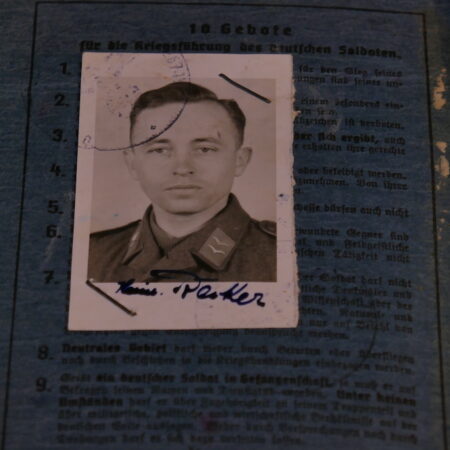
Original WWII German Luftwaffe Soldbuch – Obergefreiter Heinrich Becker – Luftgau-Nachrichten-Regiment Moskau
Issued to Becker in 1942. He served as a radioman for sometime in the following units: Luftgau-Nachrichten-Regiment Moskau The Moscow Air District Signal Regiment was established in Minsk in November 1941 with two detachments for the Moscow Field Air District: Regiment Staff from Staff / 15th Air District Signal Regiment Staff I. Detachment as a new formation 1st (Signal) Company as a new formation 2nd (Signal) Company as a new formation 3rd (Signal) Company as a new formation 4th (Signal) Company as a new formation Staff II. Detachment from Staff V. / 2nd Air District Signal Regiment 8th (Heavy Air Signal) Company from 13th / 2nd Air District Signal Regiment 9th (Heavy Air Signal) Company from 15th / 2nd Air District Signal Regiment 10th (Heavy Air Signal) Company from 15th / 2nd Air District Signal Regiment 11th (Heavy Air Signal) Company from 32nd / Air District Signal Regiment 2 12th (Heavy Air Signal) Company as a New Formation The regiment was deployed with its headquarters and 1st Battalion in Minsk and 2nd Battalion in Pinsk. In April 1942, the regiment transferred the 9th Heavy Air Signal Company to the 2nd Air District Signal Regiment as the new 15th Company. The company was subsequently reorganized. In October 1942, the 4th Company was transferred to the 82nd Air District Signal Regiment as the 1st Company and was reorganized from the 4th / Air District Signal Regiment Kharkov in April 1943. In June 1943, the regiment was renamed the 27th Air District Signal Regiment. The 4th Company of the regiment was reorganized as the 4th / Air District Signal Regiment 25 in April 1944 and reorganized in Kolodishchi a month later. The regiment was disbanded on September 2, 1944. The 1st Company became Air Intelligence Operations Company 104, while the 10th – 12th Heavy Air Signaling Companies remained as independent companies. They were deployed in the Radom/Warsaw area in 1945, where they suffered heavy losses. Luftgau-Nachrichten-Regiment 2 The 2nd Air District Communications Regiment was formed on 30 September 1939 for the newly formed Air District 2. The regiment initially consisted of: 1st (Telephone) Company 2nd (Staff Communications) Company 3rd (Telephone and Telex Operations) Company 5th (Air Reporting) Company 17th (Replacement) Company Over the next two years the regiment was reinforced to include: Regimental Staff I (Operations) Department II (Air Reporting) Department III (Replacement) Department V (Air Reporting) Department with a total of 23 companies. The II (Air Reporting) Department, set up at the beginning of May 1940 with 8th – 10th Companies, relocated to the Black Forest after it was fully formed and was deployed in the 7th Army sector on the Upper Rhine. From June 15, 1940, the division participated in the 7th Army’s advance into Alsace. After the armistice, the division moved via Trier and Luxembourg to Etampes in France. From there, the division marched to the Atlantic coast and took up positions from the Spanish border to the mouth of the Loire. It would seem he was drafted into a replacement driving unit and was captured, and returned to his sector in Germany. July 1942 – Issued a K98 Rifle and Bayonet. Rare Merkblatt for Plants fit for Consumption !! Awarded: Trades Badge for Drivers – July 1944. Interesting ID for – French Occupied Zone in Germany Post War with period photo.
-

Original WWII German Army Soldbuch – Obergefreiter Karl Haas – 353 Infanterie Division – Siegfried Line – POW – EK2 – West Front
Soldbuch issued to Karl Haas in October of 1942. Non-Regulation Photo with Side Cap! Served in the following frontline units: Reserve-Grenadier-Bataillon 208 On October 20, 1942, the battalion was divided in Nancy into an Infantry Replacement Battalion 208 and a Reserve Infantry Battalion 208. From that day on, the replacement battalion was subordinate to Division 462. The reserve battalion was subordinate to the 182nd Reserve Division after its formation. The two battalions were renamed Grenadier Replacement Battalion 208 and Reserve Grenadier Battalion 208 on November 7, 1942, respectively. The replacement battalion was relocated to Metz on December 3, 1942. The Reserve Grenadier Battalion 208 was relocated to Versailles near Paris on September 14, 1943. Grenadier Regiment 226 – 79 Inf Div – Later 79 VGD On January 31, 1944, the 1st Battalion of the 731st Grenadier Regiment of the 711th Infantry Division (15th Wave of World War XII), which had already been relocated from west to east in October 1943, was incorporated as I./G.R.226. On July 7, 1944, I./G.R.226 was replaced by the 1st Battalion of the 993rd Grenadier Regiment of the 278th Infantry Division (22nd Wave of World War XII from Italy). The 2nd Battalion of the regiment was disbanded in the summer of 1944, leaving G.R.226 to consist of the 1st and 3rd Battalions. At the end of August 1944, the regiment was again defeated in the Jassy Pocket. A few smaller groups managed to break through to Hungary via the Capes. On October 27, 1944, the Grenadier Regiment was re-established with the 1st and 2nd Battalions as part of the formation of the 79th Volks-Grenadier Division. November 1944 – Festungs Pak Kompanie 1/XIII The headquarters of Fortress Anti-Tank Unit XIII was established in December 1944 in Straubing in Wehrkreis XIII. In February 1945, the headquarters in the west was destroyed and reorganized in March 1945 by renaming it the headquarters of Fortress Anti-Tank Unit XXII. Between December 1944 and January 1945, the 353rd Infantry Division operated as part of the LXXXI Army Corps at the Westfall defensive fortifications (Allied parlance: “Siegfried Line”), where it launched a major counterattack on 2 December, which was eventually beaten back by U.S. artillery. The 353rd Infantry Division was eventually trapped in the Ruhr Cauldron, where it went into American captivity around April 1945.[1] The division’s final commander was Colonel Kurt Hummel, who assumed command on 15 February 1945. Equipment – K98, P38 Pistol (Likely as MG Gunner) Injuries – Wounded in June 1943 – Grenade Splinter in the buttocks left side, found fit for service in May of 1944. Awards – Wounds Badge in Silver, Iron Cross Second Class, Iron Cross First Class (No stamp but looks good for the time 2.1945).
-
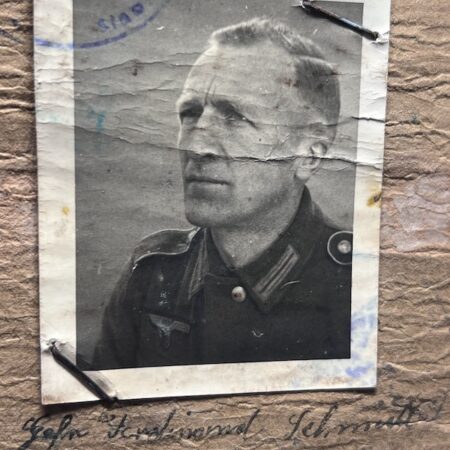
Original WWII German Wehrmacht Soldbuch – Obergefreiter Ferdinand Schmidt – Grenadier Regiment 861
Original WWII German Wehrmacht Soldbuch Obergefreiter Ferdinand Schmidt Grenadier Regiment 861 – 341 Infanterie Division The Soldbuch is incomplete! Seems he was assigned from January 1945 with the above unit: On December 2, 1944, the division’s command post was located in Püttlingen. On December 4, 1944, the division still had a combat strength of 2,600 men, including 800 infantry. A report from Army Group G dated December 6 stated: “Composed mainly of untrained Luftwaffe soldiers and stragglers; due to poor weaponry, low combat value, unsuitable for large-scale combat. During the night of December 8, 1944, the division withdrew to the Fenne-Klarenthal-Petite Rossel line on the Saar. It remained quiet there for the following days. From 11 p.m. on December 31, the division participated in Operation “Nordwind,” the German offensive in Alsace and Lorraine. By morning, the division had captured Schaffhausen, the forest east of Werbeln, and the settlement 1 km east of Ludweiler. On January 2, the heights southwest of Wehrden were taken. The division then remained in the positions it had reached as flank protection for the 1st Army. From February 1945, there was increased fighting and heavy casualties in the division’s area south of Saarbrücken on the Spichern Heights. Artillery bombardment. In the battle for the West Wall positions in this area, the division suffered heavy losses in the following weeks. On March 2, 1945, the division was relieved by the 559th Volksgrenadier Division and relocated behind the front line. During the night of March 13, 1945, the 347th Infantry Division relieved the 559th Volksgrenadier Division in its sector of the front. The division initially relocated its command post to Fischbach. Here, it was within the firing range of long-range American artillery. On the afternoon of March 13, the command post then relocated to Wahlscheid. The enemy remained quiet in the entire division sector for the next few days. During the night of March 18, 1945, the division withdrew to the Püttlingen-Völklingen line. The Americans only hesitantly followed the retreat of the division and the entire LXXXV. The division was then reunited near Homburg. the Saar and northeast of the city. During the night of March 20, 1945, the division received orders to withdraw to Homburg and secure the Vogelbach-Homburg line against any American forces attacking from the north. Following on the right, the 719th Infantry Division was to assume security on both sides of Landstuhl. The division’s command post was located in Bildstock. On March 20, 1945, the LXXXV Army Corps received orders to secure the northern flank of the XIII SS Army Corps, which was deployed in the west of the Palatinate Forest, with the weak remnants of the 347th Infantry Division, the 719th Infantry Division, and the 19th Volksgrenadier Division. The three divisions engaged in hard and heavy fighting against vastly superior American forces between March 20 and 22, 1945. The 347th Infantry Division defended a section southeast of Homburg. The division was gradually pushed back and finally received orders to fight its way through the Palatinate Forest. The bulk of the 861st Grenadier Regiment and parts of the 347th Artillery Regiment were unable to retreat to the Vogelbach-Homburg area and were taken prisoner. The 860th Grenadier Regiment and the remnants of the 36th Reserve Grenadier Regiment / 880th Grenadier Regiment under its command were able to break away from the enemy and establish a new security line in the Homburg area by March 20. The divisional command post had been relocated to Knopp, about 12 km east of Homburg. On the evening of March 20, the 347th Infantry Division received orders to withdraw to the western edge of the Palatinate Forest during the night of March 21 and to secure the entrance to this forest area on both sides of Steinalben. secure. The command post was to be relocated to Johanniskreuz. Upon arrival at the eastern edge of the Palatinate Forest the following day, the division came under the command of the XIII SS Army Corps. Because the retreat roads were blocked by units of the 17th SS Panzergrenadier Division, numerous elements of the division were taken prisoner by the Americans. The division’s command post was initially set up in Eschbach and relocated to Bornheim, east of Landau, on the afternoon of March 21. The division received new orders to assemble its remnants east of Landau. However, as early as March 22, 1945, the division received orders to secure the Westheim-Oberhochstadt line, about 11 km northeast of Landau, with its remaining remnants. There was no longer any connection to the left or right. The division’s command post was in Zeiskam that day and relocated to Mühle, about 3 km south of Nieder-Lustadt, that evening. On March 23, the command post was in Nieder-Lustadt. At nightfall on April 23, the division moved to the area west of Germersheim. Retreated and secured the Rhine crossing there. The command post relocated to the barracks in Germersheim. All of the division’s remaining vehicles were transferred to the east bank of the Rhine. To support the Germersheim bridgehead, the 4th Engineer Bridge Training and Replacement Battalion and the 308th Panzer Grenadier Replacement and Training Battalion were placed under the division’s command. On March 24, heavy fighting broke out around Germersheim, during which the division headquarters was almost completely eliminated by artillery fire. The division commander acted as commander of the Germersheim bridgehead that day. That evening, the division crossed the Rhine over the bridge near Germersheim. Rear troops remained in the bridgehead on the west bank until the following morning. However, the division was thus destroyed. The remaining Grenadier Regiment 860 was subordinated to the 2nd Mountain Division, and the divisional headquarters and Signals Detachment 347 were deployed to the 7th Army. The Grenadier Regiment 860, along with all remaining elements of the division, was finally incorporated into the 47th Volksgrenadier Division on March 27, 1945. By April 12, 1945, the headquarters of the 347th Infantry Division had been re-established. It assumed command of the southern sector of…
-

WWII German Waffen SS Dog Tag – Erkennungsmarke – SS Division Wiking – Found in Ground – Original
Really interesting, original Dog Tag for a member of the Feld Ausbildungs Batl of the the Wiking. Found in this year in the ground. Price includes Shipping World Wide




